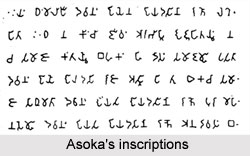 Ashoka"s Inscriptions provide enough knowledge about the reign of Ashoka. His inscriptions are found on the rocks, and the pillars scattered from the Himalyas to Mysore and Odisha to Kathiawar. The object of his inscriptions is religious and ethical. These inscriptions can be divided into three categories- rock edict, pillar edicts, and cave inscriptions.
Ashoka"s Inscriptions provide enough knowledge about the reign of Ashoka. His inscriptions are found on the rocks, and the pillars scattered from the Himalyas to Mysore and Odisha to Kathiawar. The object of his inscriptions is religious and ethical. These inscriptions can be divided into three categories- rock edict, pillar edicts, and cave inscriptions.
Rock Edicts of Ashoka"s Inscriptions
The rock edicts may be further classified into several heads such as the minor rock edicts, fourteen rock edicts, Kalinga rock edicts and Bhabru rock edict.
Minor Rock Edicts: These rock edicts belong to 258 or 257 B.C. They are of two types. One type of the minor rock edict can be found in the Shabhaz district of Bihar, Bairat district of Rajasthan, and Jabalpur district of Madhya Pradesh. The minor rock edicts of the other type have been found at Brahmagiri in Mysore and at Rameshvaram. The first enlightens us with the personal life of Ashoka while the second contains a code of morals.
Fourteen Rock Edicts: These have been found at the following places- Shabhazgarhi in Peshawar district, Mansera in Hazara district, Kalsi in Dehradun, Girnar near Junagarh, Sopara in Thane district, Dhauli in Puri district, Jangarh in Ganjam district, and Ira Gurhi in Karnal district.
Kalinga Rock Edicts: Two Kalinga rock edicts can be found at places called Dhauli and Jangarh. These inscriptions belong to 256 B.C. These rock edicts refer to the administrative systems through which the people of Kalinga and other frontier states should be administered.
Bhabru Rock Edict: This rock edict was placed near Viratt in Jaipur. Dr. Smith fixes its date from 258 to 257 B.C. In this inscription Ashoka expressed or rather confessed his faith in the Buddha, Dharma and the Samgha. He also refers seven examples of Buddhism which his subjects should also follow.
Pillar Edicts of Ashoka"s Inscriptions
The pillar edicts may be further classified into three categories. The name can be mentioned as seven pillar edicts, two commemorative pillar inscriptions, and four minor pillar edicts.
Seven Pillar Edicts: These have been found at six places. Two pillar edicts have been found at Delhi. The other pillar edicts have been found at Meerut, Prayag, Ambala district and also in Champaran etc.
Two commemorative Pillar Inscriptions: These inscriptions have been found in the Terai of Nepal at Rummindai and Nigilava villages. These describe Ashoka`s Dharmyatras and the holy places of Buddhism. These inscriptions belong to 246 B. C.
Four Minor Pillar Edicts: Two of these minor pillar edicts have been found at Sanchi and the other two have been found at Prayag. These inscriptions were issued to remove the differences of Buddhism.
Cave Inscriptions of Ashoka"s Inscriptions
The cave inscriptions are three in number and have been found in the Barabar hills. These describe Ashoka`s policy of toleration and charity. These inscriptions belong from 257 to 250 B.C.
Language and the Script of Ashoka"s Inscriptions
All the inscriptions of Ashoka are in Prakrit language and Bramhi script has been used to write them. Only the inscriptions of Mansera and Shahbazgarhi have been written in Kharoshti script, which is written from right to left whereas the Bramhi script is written from left to right.






































